I was sitting at my drawing desk and was thinking if it is okay to use a ruler in the artwork I was about to do. I needed to do a speedy sketch but the straight lines drove me crazy. Something I read in an online community also came to my mind. According to that using a ruler when drawing freehand or painting was not okay because it is cheating in art. I did a little research on the topic and here is what I have found.
Using a ruler is never considered cheating in art as you are not supposed to draw perfectly straight lines. Use a ruler if it can speed up the art process and delivers on expectations. Freehanding straight lines without a ruler is important on occasions it delivers the best results.
Time is something significant in this competitive creative space. Therefore using any tool that can speed up the process but delivers the expected quality is smart. However, learning different ways of drawing straight lines using a ruler or not, gives you more control over the results.
Is it okay to use a ruler in art?
It is okay to use a ruler in art if it can improve the final art piece. Using a ruler is not cheating as per the opinion of many artists. The ruler helps to create geometrical architectural pieces as well as technical drawings precisely. A ruler may even make the artistic creative process easier and faster.
An artist may wonder whether they should use a ruler to draw straight lines and to measure proportions. It may make them rely on rulers for straight lines and may even reduce their creativity and visual perception. As a beginner artist, it is best if you could use a tool like a ruler after properly practicing freehanding straight lines. In that case, it will be advantageous for you as the artist to use the ruler to speed up the creative process.
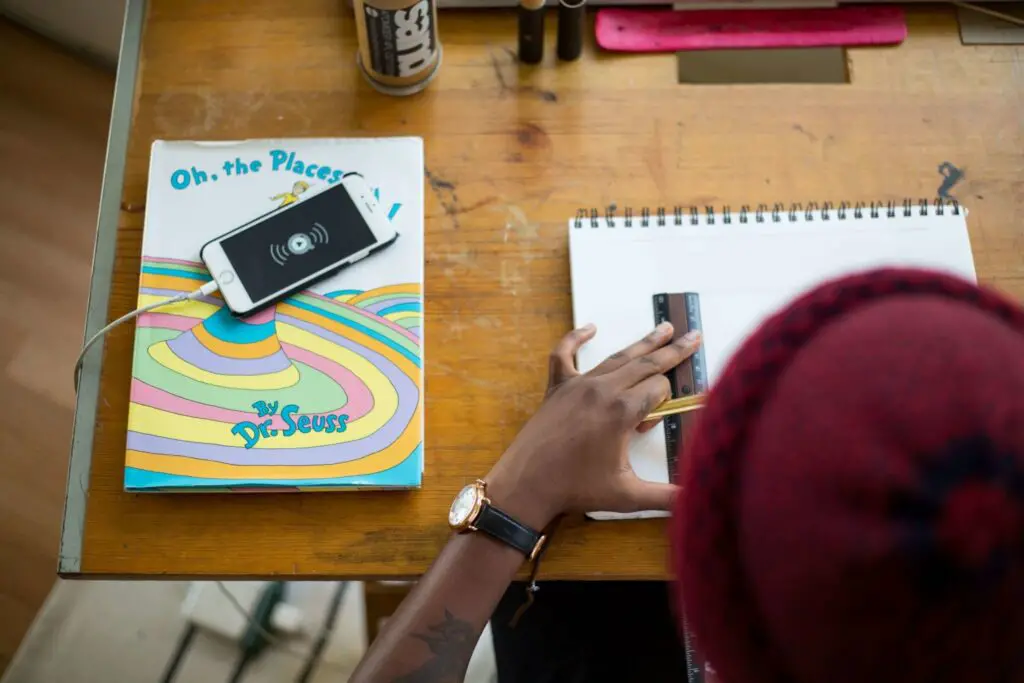
Creating those geometrical architecture pieces freehand could be a hard task. Because it may take more practice to perfect drawing straight lines free hand. Also, It may not deliver on your expectations in the beginning.
I use a ruler to draw straight lines oftentimes in my artwork. But I thought I could also learn how to freehand straight lines. Because it can add a new dimension to my artwork and may improve it more. Also, I saw many artists draw straight lines freehand, so why not me?
I also think drawing freehand, even straight lines with our instincts help us express our ideas better. It may help us improve our drawing skills. However, if you are doing a technical drawing, it needs more information about the subject and needs to be precise.
You are not cheating in the art unless you copy the artwork of another artist. If you want to know more details on copyrights in art and many misconceptions like using tools are cheating in art, in more detail, read my article; What is cheating in art? (Everything you need to know).
Perspective drawing with a ruler
Fine artists also use a ruler to practice perspective drawing. Perspective drawings are important when we need to draw living objects in three-dimensional (3D) ways on two-dimensional (2D) surfaces. Many artists also draw anatomies using perspective drawing techniques. You can go into great detail about perspective drawings, but I will keep it short here.
There was an artist called Johannes Vermeer, a Dutch-born artist who specialized in domestic interior scenes of middle-class life. He painted most of his paintings, emphasizing three-dimensional depth as much as possible. But the fantastic thing is that all his perspective drawings were done by his hand without a ruler or straightener. His capability to draw freehand was considered extraordinary. Unfortunately, there are no longer any remaining draft drawings, so there is no evidence to support his abilities.
Painting straight lines with a ruler
A ruler is not only used in drawings but also in paintings. It will become harder to paint straight lines to the speed eventually. This is because our hands become shaky when we become old folks or due to some unfortunate illness. keeping our hands steady during many straight lines in a painting is difficult.
In this case, artists use rulers as a tool to help them make straight lines easily. You will often need straight-line paintings when doing buildings, fences, boat ropes, etc. One way of using a ruler to make straight lines in a painting is to use the ruler as a stamper.
First, dip the edge of the ruler in paint or paint the edge of the ruler and then stamp on the painting where necessary. This easy and fast way of making straight lines is particularly good for sailboat ropes or similar. For thinner lines, you can use gift cards, an old credit card, an edge of a palette knife, or similar sorts of things.
Some artists prefer a T-squares ruler in place of a regular ruler. Some artists make straight lines with the ruler and then touch up any little goofs freehand. It’s important to be patient in the process as it may take some time to get used to.
You can paint straight lines with a paintbrush using a ruler as with a pencil. Protect the ruler with masking tape and then use the paintbrush to make straight lines with a ruler just like you would with a pencil.
Tips to paint straight lines without a ruler
If you are a painter and trying to do straight lines, the type of brush used matters. You can use a synthetic, sharp-edged flat brush or angled flat brush for straight lines, rather than using a round detail brush. Do longer strokes first and then do shorter strokes to fill any gaps.
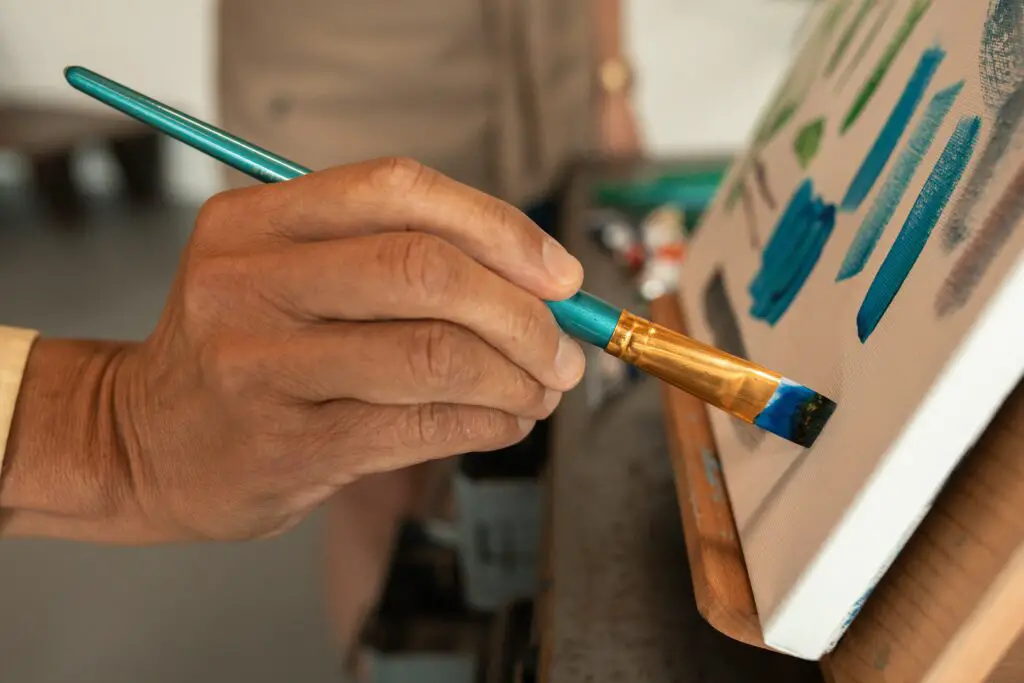
You can use a Mahl stick that is about 33 Inches in Length. It is used to steady the painter’s hand. You can use this stick as a guide or support to paint or draw straight lines. There are some DIY options for the Mahl stick. You can make one yourself with a one-inch PVC pipe and wrap its top end with foam tape.
You can even use pieces of cardboard for straight lines. Some even use painter’s tape or airbrush tape. However, your painting needs to be well-dried to put any kind of tape on it. This method is best for thicker straight lines. I do not recommend this method as it can damage the painting if not done with care.
One tip suggested by an artist for painter’s tape is that put its sticky side down on your clothes several times to put lint on it and make it less sticky. Then it comes off gently from the painting without taking the paint with it.
Sometimes you may find that you can paint horizontal straight lines more easily than verticle ones. In this case, you can turn the canvas and make horizontal lines where you need verticle lines.
Some artists even use mixed media when drawing straight lines. They use sharp-edged markers like acrylic markers or POSCA pens on the painting. However, be mindful of the lightfastness and longevity of these different media in the artwork. It is best if all media has similar longevity in a painting.
Artists who use rulers for straight lines
I thought it would be interesting to get to know artists who use rulers in their artwork. I have found that there are quite a few artists who use rulers in their perspective drawings. Let’s see some of the YouTube artists who use rulers in their art.
DP Art Drawing
The artist at the DP Art Drawing YouTube channel is very talented. He uses many tools to draw excellent drawings and create new art styles. Also, he used a ruler to draw a straight line. He combines each line to reveal the completed mesmerizing artwork. His mind-blowing art style has gone viral on YouTube. The secret to the virality of his videos is his new experiments.
Delmus Phelps
Delmus Phelps has been an artist for over 40 years. He is a master of oil painting. He runs a website called “easy oil painting techniques,”. On that website, he writes about techniques for oil painting beginners.
He uses a straight edger for his works to draw straight lines in oil paints and continues a YouTube channel by his name and teaches about oil painting. He is such a nice artist, and you can go and check out his
channel and website.
Not only the artists today, but even the masters of the past also have used rulers when drawing. Leonardo da Vinci, best known for his expressive artworks, also used a grid method to draw live subjects accurately.
Simple artwork using a ruler
As I got to know using a ruler is not cheating in art, I was free of mind to use it for my artwork. So I thought of sharing with you some of the practice tests I have done and a simple architectural drawing piece with many straight lines.
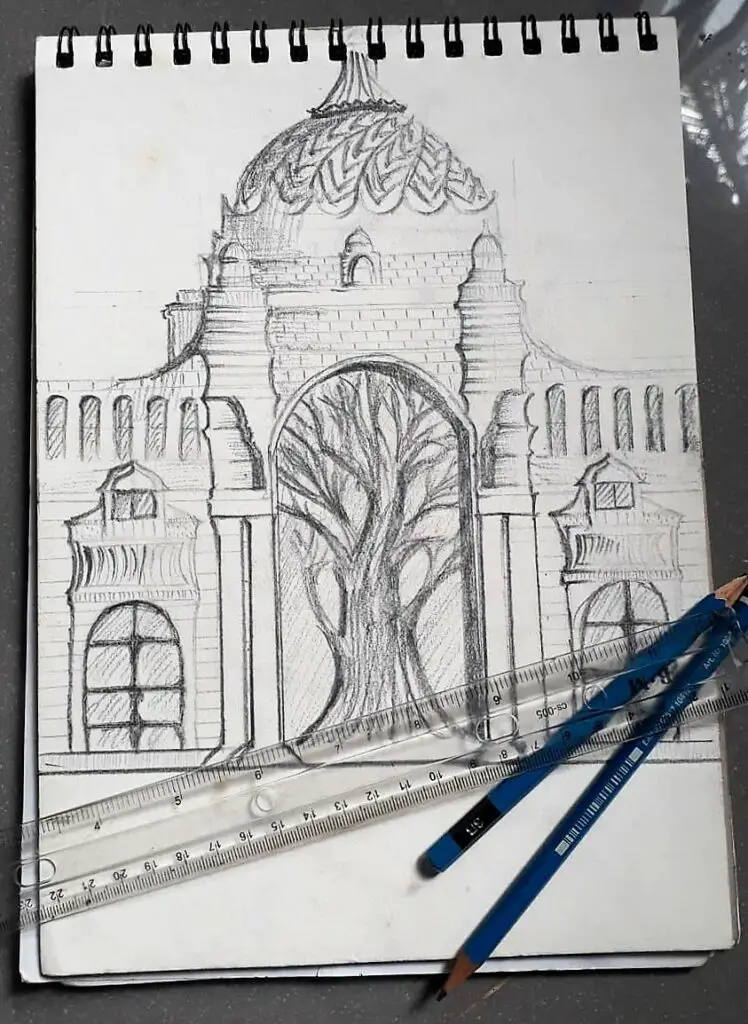
Use of rulers in digital art
In general, when it comes to digital art they cannot do without rulers in digital applications. Digital artists use pen tablets or pen display tablets to draw using illustrating software. If you are a digital artist and think that using rulers in digital art is cheating, it is not.
Some beginner artists may need more practice with the devices for drawing. They may have perspective drawing issues. Almost all digital drawing application developers had to introduce a ruler and gride as an application feature to eliminate this.
In Clip Studio Paint, you can open a grid from the layer drop-down menu and select the Ruler/Frame option. Clip Studio Paint states that this option is for someone who has previously struggled with perspective.
Pros and Cons of Using a ruler in art
After considering what I have learned, the following are the pros and cons of using a ruler in art. There are no rules in art, and everyone is free to use tools to improve their work, save time, or develop a new style. However, as an artist still studying and experimenting with art, I’ve outlined the pros and cons for you to consider
Pros of using a ruler in art
- The ruler makes it easier to draw straight lines without much effort
- The ruler will save time if there is a tight schedule
- Using a ruler can help you to draw straight lines more accurately and with cleaner results.
Cons of using a ruler in art
- A budding artist’s creative process may be interrupted by using a ruler
- You may become guilty of not being able to draw straight lines free hand
- You may become lazy in practicing freehand drawing with a developed sense of reliance on rulers
Freehanding straight lines without a ruler
When teaching art theory, it would be more accurate to say that there are no rules in art. We must go beyond what others have previously created to push the limits. Generally, artists need to avoid playing it safely and appeasing the teacher in favor of producing work they believe the instructor would appreciate.
The same goes for pleasing your family and friends, who have the power to influence you. If you consistently try to please them, you will need more time to become a confident artist who expresses emotions through the work. These were the thoughts of many artists in online art forums.
In nature, there are no straight lines. So it is essential to train your creative eye to take a general measure of the lines without a ruler. By doing this, you can understand things more clearly through the natural process of “seeing, experiencing, to perceiving.” This process does not need to be in a sequence depending on the complexity of the artwork.
How to draw straight lines without a ruler?
I needed to know how to practice drawing straight lines like other artists. I did a little research and found the following awesome advice on improving freehand straight-line drawing skills.
Fun and easy way to draw straight lines
Mark the two ends of the straight line with two dots. Then move the ruler lightly back and forth until the hand can easily find the line. At this point set aside the ruler and draw a straight line without stressing. This is how a teacher has shown his students to perfect straight lines. As always the more you practice the better you will get at it.
I have used this method not only for straight lines but generally for any shape. It is easier to draw lines between points rather than drawing all at once. Some artists like “Michelle the Painter” use this method when teaching art, as this is an awesome drawing technique, especially for beginners.
Keep the wrist steady and pull from the shoulder to draw straight lines
Another great way to practice freehand straight lines is to maintain a rigid wrist and pull from the shoulder when drawing lines. As the shoulder muscle is stronger it can steady the hand well. Make similar, numerous, long, swift strokes on the paper of horizontal, vertical, and angled lines, while gently pressing the hand on the paper. It will make it harder if you try to press your hand harder on the paper and try to draw the lines.
If we can practice this method every day for a few minutes, we can perfect drawing straight lines freehand without using a ruler. So do a bunch of practice tests on paper before going for the actual art project.
I practiced drawing straight lines freehand following the two techniques I mentioned previously. I kept the wrist steady and pulled from the shoulder to draw straight lines. I felt like my straight lines are improving. So I continued at it. The results were awesome! I realized that practice will improve my skill and uplift my confidence.
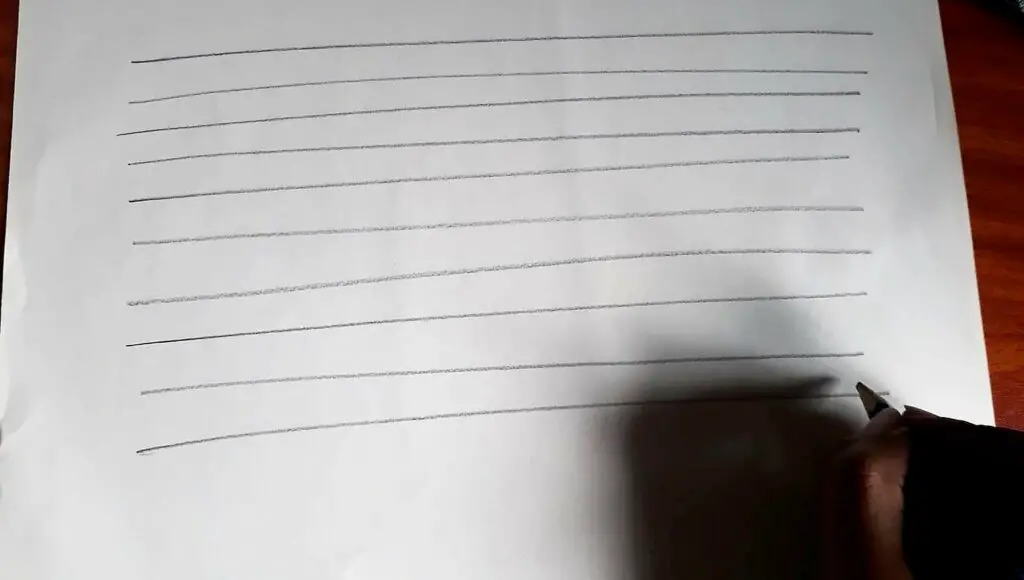
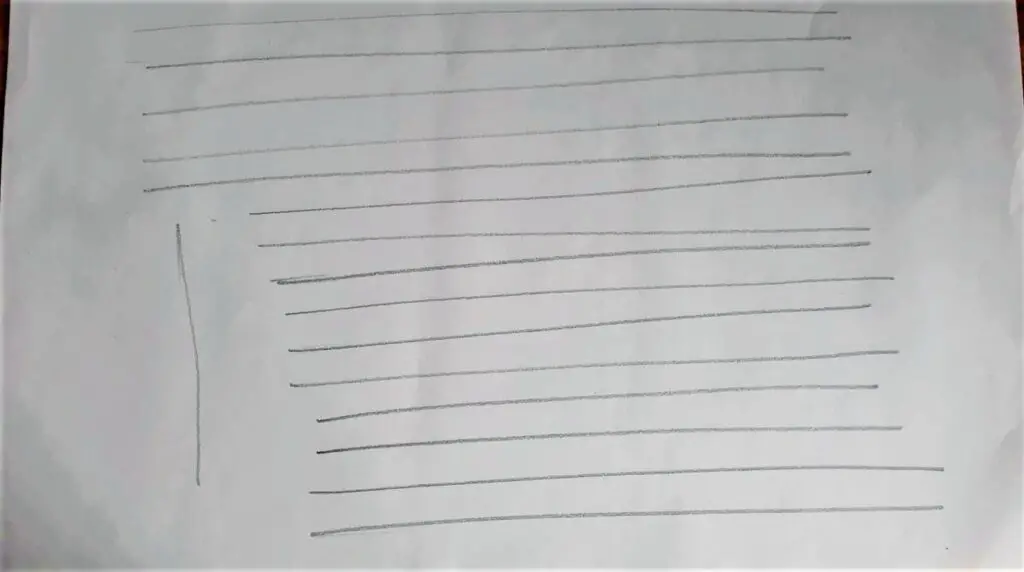
Benefits of freehand drawing
Freehand drawing is using our hands and a pencil to draw. It is a natural process that helps us boost self-confidence and improve our perception of the things in the world. As you already know artists see the world differently. They see the things around us as lines, shapes, colors, forms, and values.
Beginner artists try to copy what they see, most of the time. However one of the best approaches is to see a particular subject that you are going to draw, as a whole. If you try to copy every part of a subject as it is, it will become a little harder, unless you are doing a realistic drawing.
Another tip to draw more freely is to see the things in the environment more freely. You do not have to remember that a chair has four legs and it should be like that. You can open your mind and see the chair from a whole new and creative perspective, and then try to draw it. This way you’ll be met with a lot of surprises.
Creative individuals will ultimately understand their preferences via patience and an open mind because understanding is necessary for expressing feelings. Once you gain the courage to accept your mistakes, it will encourage you to do more mistakes and learn through mistakes.
Therefore, Keep trying, skip the shot cuts study the subject, look at how to do it, and draw. After you finish, Find out what worked well about your strategy and why certain things worked successfully, and then consider what can be improved because trying, again and again, is a smart idea.
Step outside your comfort zone and give a try drawing other subjects; the experience you gather will help you create better work in any style. Professional artists always say that there are no rules or guidelines to express our thoughts through art. Pablo Picasso once said, “Learn the rules like a pro so you can break them like an artist.” (source)
Conclusion
It is not considered cheating to use a ruler to draw straight lines in a drawing or a painting. However, the natural drawing method, called the freehand method, is considered a perfect way to practice being an artist and focus on increasing the skill level of drawing.
Using any tool in your artwork is not considered cheating unless you are copying another artist’s artwork. If a tool can speed up the process and delivers on expectations using that tool is a smart idea. Always try on improving your creative process, with or without a ruler.
My experiments, the knowledge you gained from my research, how it made me feel to use a ruler in art, and the guilt I felt for cheating will assist you in overcoming your fear of drawing straight lines with or without a ruler.


